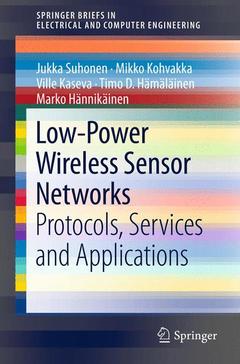Low-Power Wireless Sensor Networks, 2012 Protocols, Services and Applications SpringerBriefs in Electrical and Computer Engineering Series
Auteurs : Suhonen Jukka, Kohvakka Mikko, Kaseva Ville, Hämäläinen Timo D., Hännikäinen Marko

Wireless sensor network (WSN) is an ad-hoc network technology comprising even thousands of autonomic and self-organizing nodes that combine environmental sensing, data processing, and wireless networking. The applications for sensor networks range from home and industrial environments to military uses. Unlike the traditional computer networks, a WSN is application-oriented and deployed for a specific task. WSNs are data centric, which means that messages are not send to individual nodes but to geographical locations or regions based on the data content. A WSN node is typically battery powered and characterized by extremely small size and low cost.
As a result, the processing power, memory, and energy resources of an individual sensor node are limited. However, the feasibility of a WSN lies on the collaboration between the nodes. A reference WSN node comprises a Micro-Controller Unit (MCU) having few Million Instructions Per Second (MIPS) processing speed, tens of kilobytes program memory, few kilobytes data memory. In addition, the node contains a short-range radio, and a set of sensors. Supply power is typically obtained with small batteries. Assuming a target lifetime of one year using AA-size batteries, the available power budget is around 1 mW.
This book covers the low-power WSNs services ranging from hardware platforms and communication protocols to network deployment, and sensor data collection and actuation. The implications of resource constraints and expected performance in terms of throughput, reliability and latency are explained. As a case study, this book presents experiments with low-energy TUTWSN technology to illustrate the possibilities and limitations of WSN applications.
Date de parution : 01-2012
Ouvrage de 83 p.
15.5x23.5 cm



